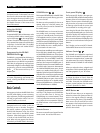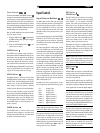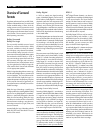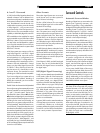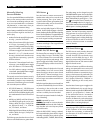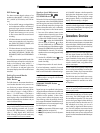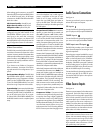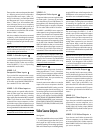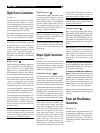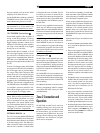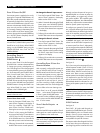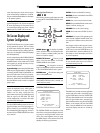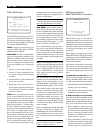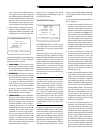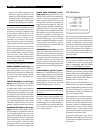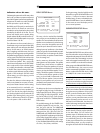
20
Digital Source Connections
See Figure 4.
The RSP-1066 provides digital connections
which may be used in place of, or in addi-
tion to, the analog audio input and output con-
nections described in the previous sections.
These connections include five digital inputs
and two digital outputs for recording.
These digital connections can be used with
any source component that supplies a digital
signal, such as a DVD player or CD player.
NOTE
: A digital connection means that the digi-
tal processors in the RSP-1066 will be used
to decode the signal, rather than the source
component’s internal decoders. In general,
you must use digital connections for a DVD
player or other component that supplies a
Dolby Digital or DTS signal, otherwise the
RSP-1066 will not be able to decode these
formats.
Digital Inputs
The RSP-1066 accepts digital input signals from
source components such as CD players, sat-
ellite TV receivers, and 5.1 channel Dolby
Digital, DTS, or 6.1 channel DTS ES signals
from DVD players. The built-in D/A converter
senses and adjusts to the correct sampling rates.
There are five digital inputs on the rear panel,
three coaxial and two optical. These digital
inputs can be assigned to any of the input
sources using the INPUT MENU screen de-
scribed later in this manual. For example, you
can assign the COAXIAL 1 digital input con-
nector to the VIDEO 1 source and the OPTI-
CAL 2 digital input to the VIDEO 3 source.
Connect the appropriate cable (optical or 75
ohm coaxial) from the digital
output
of your
source component to a digital
input
on the
RSP-1066 and then configure that digital in-
put for use with the source component using
the INPUT MENU.
NOTE
: When using digital connections, you
should also make the analog audio input con-
nections described previously. The analog
connection is necessary to record to an ana-
log recorder or for ZONE 2 operation
Digital Outputs
The RSP-1066 has a digital output (with a choice
of coaxial or optical connectors) to send the
digital signal from any of the five digital in-
puts to a digital recorder or outboard digital
processor. When a digital input source sig-
nal is selected for listening, that signal is au-
tomatically sent to both digital outputs for re-
cording or outboard processing.
NOTE
: Only digital signals from source com-
ponents are available at these outputs. Ana-
log signals cannot be converted and are not
available at the digital outputs.
Connect the digital
output
to the digital
input
of your recorder or processor. You can use
either a 75 ohm coaxial video cable or an
optical cable.
Output Signal Connections
See Figure 3.
This section of the manual describes the au-
dio and video signal output connections on
the RSP-1066. These are used for routing the
output signals to television monitors, audio am-
plifiers, and recording devices.
TV Monitor Output
The video output of the RSP-1066 sends the
video signal to your TV monitor. Three types
of video output connections are provided –
RCA composite video, S-Video, and Compo-
nent Video. Choose the type of video output
connection that matches the type of video input
connections you have made. Connect the TV
MONITOR
output
, from either RCA compos-
ite or S-Video or Component Video connec-
tor, to the corresponding
input
on your televi-
sion monitor, using appropriate video cables.
NOTE
: The RCA composite video output only
sends signals from RCA composite video
source inputs to the TV monitor. The S-Video
output only sends signals from S-Video video
source inputs to the TV. The Component Video
output only sends signals from Component
Video source inputs to the TV. If you have
connected all of your source components with
the same type of connection, then you only
need to make one connection from the
RSP-1066 to the TV monitor. However, in a
mixed system with, for example, some S-Video
and some RCA composite inputs, you will
need to make two connections to the TV moni-
tor and use its input selector to switch be-
tween the two when changing sources.
NOTE
: The ON-SCREEN DISPLAY system is not
available when using Component Video con-
nections to the TV monitor
Preamp Outputs
There are ten RCA preamp audio outputs:
FRONT (LEFT/ RIGHT), CENTER (1/2), SUR-
ROUND REAR (LEFT/RIGHT), CENTER BACK
(CB1/CB2), and SUBWOOFER (1/2). Use
these outputs to send the RSP-1066’s output
signals to powered speakers or external am-
plifiers.
NOTE
: Depending on your system configura-
tion, you may use some or all of these con-
nections. For example, if you only have one
center channel, you would connect it to the
CTR 1 output. If you only have one center
back channel, you would connect it to the
CB1 output.
To hook up a powered subwoofer,
connect a standard RCA audio cable from the
SUBWOOFER OUTPUT jack to the input on
the subwoofer’s power amp.
To hook up the RCA main audio out-
puts, connect an audio cable from each
output
to the
input
of the amplifier channel that will
power the corresponding speaker. In a full home
theater system, you will need to make six dif-
ferent connections corresponding to the six
speakers (left front, center front, right front, left
surround, right surround, and subwoofer).
Make sure that you have each output connected
to the correct amplifier channel (front right, left
rear, etc.).
Power and Miscellaneous
Connections
AC Input
Your RSP-1066 is configured at the factory for
the proper AC line voltage in the country where
you purchased it (USA: 115 volts/60Hz AC
or CE: 230 volts /50 Hz AC ). The AC line
configuration is noted on a decal on the back
of your unit.
RSP-1066 Surround Sound Processor



